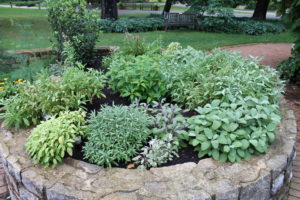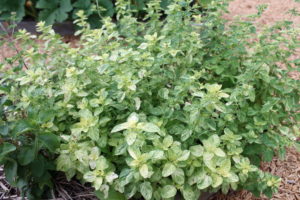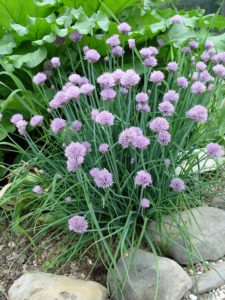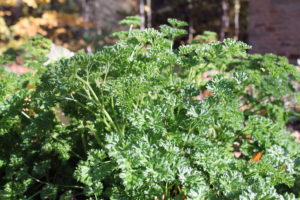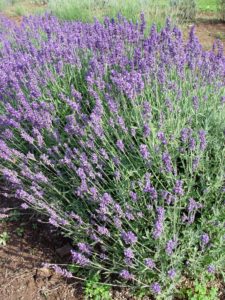10 Easy-to-Grow Cooking Herbs
You could keep paying $3 or more for a packet of fresh herbs at the grocery store.
Or you could start growing your own herbs for pennies – even fresher and at arm’s reach whenever you need a sprig or two for dinner. Most cooking herbs are easy to grow, too.
And many of them have scents and strong flavors that make them less attractive to foraging deer and rabbits – the bane of many vegetable gardeners.
If you’re interested in adding a few good herbs to the garden this spring, here are 10 of the most kitchen-useful ones that I think are worth growing:
1.) Basil. A tender, leafy annual that’s usually grown in its green-leaf form but also comes in an attractive purple-leaf form.
Growing it: Direct-seed into the garden or transplant young plants after all danger of frost in May and June. Sub-freezing nights will kill basil. Snip leaves throughout the season as needed. Plants will continue growing new leaves until frost kills them in fall. Grow in full sun to light shade.
Using it: The perfect complement to tomatoes, basil leaves are often used in pesto but also work well in tuna, potato and egg salads, in marinades or in herbal butter. Can be used fresh or dried.
2.) Sage. One of the most attractive herbs, sage comes in purple-leafed and purple-cream-green variegated forms in addition to the common gray-green type.
Growing it: Transplant plants in spring. Ones you’ll find in the herb section are winter-hardy. Just avoid planting in wet clay. Harvest leaves as needed throughout the growing season. Frost will brown out the leaves in fall. Trim back the plants at winter’s end to about ankle-high to keep them compact. Best in full sun.
Using it: Uses include seasoning sausage, poultry, stuffing, pork, lamb, seafood and vegetables. Sage also makes a tasty rub for pork chops or pork tenderloin. Can be used fresh or dried.
3.) Thyme. A low, creeping, small-leafed perennial herb that comes in green, gold-green and white-green variegated forms.
Growing it: Can be started directly from seed in the garden but usually is planted as a young transplant in early spring. Harvest continuously throughout the season as needed. Will brown out with fall frost but survives most winters, so long as you’re not growing it in soggy clay. Clip off any dead or overly long foliage at winter’s end. Grow in full sun or light shade.
Using it: Add leaves to stuffing, meat marinades, soup and sauce seasonings and in herbal oils and butters. Can be used fresh or dried.
4.) Greek oregano. A mat-growing perennial herb that gets tiny pinkish flowers in summer.
Growing it: Similar to thyme, oregano is winter-hardy, except in soggy clay. Can be direct-seeded into the garden but is usually transplanted as a young plant in spring. Harvest leaves as needed throughout the season. Frost will brown out the leaves in fall. Trim back to a few inches at winter’s end, and new growth will push out when the weather warms. Grow in full sun to light shade.
Using it: In the kitchen, the leaves are ideal in just about any Italian dish as well as in soups, casseroles, sauces, stews, stuffings, chili and eggs. Can be used fresh or dried.
5.) Chives. An onion-family perennial that has pointed, upright green leaves and pin-cushion-like pink spring flowers.
Growing it: Transplant plants in spring. Cut off flowers right after they fade. Clip leaves right to the base as you need them throughout summer. Flavor is best in spring and can stronger in hot summer. Foliage will brown out after several cold freezes. Cut it then or at end of winter to make way for new growth in early spring. Best in full sun.
Using it: Adds a mild onion flavor to vinegars, soft cheeses, salads, butters and oils. Best used fresh but also can be dried.
6.) Dill. An annual herb with ferny, wispy foliage and small yellow flowers that follow with small edible seed clusters in summer.
Growing it: Grows best from seeds planted directly in the garden after threat of frost. Can be transplanted, but handle gently. Fresh leaves – “dill weed” – can be snipped as needed throughout the season. But if you’re also interested in harvesting seeds, stop snipping to allow flowers and seeds to form. When seeds brown and start to dry, clip the clusters and let them finish drying on paper inside. Best grown in full sun.
Using it: Seeds go well with onions, cabbage and potatoes and can be added to casseroles, lamb, fish, vegetables dishes and sauces. Dill weed can be added to soups, stews, casseroles, meat dishes, pasta, eggs and assorted sauces, butters, dips and cheeses. Foliage is best used fresh. Seeds are best used dried.
7.) Parsley. An upright, green leafy herb with stems reminiscent of celery.
Growing it: Parsley is sold as an annual but survives most winters to give you a second spring harvest. Plant new when shoots start producing flower stalks and taste turns too strong. Can be started from seed inside or directly in the garden, or can be grown from early-spring-planted transplants. Can be grown in full sun to light shade.
Using it: Ideal as a garnish, seasoning or breath freshener when used fresh or can be dried and used in soups, stews, gravies, salads and meat or potato dishes. Best used fresh but also can be dried.
8.) Rosemary. One of the stronger-tasting herbs, this upright, bushy, fine-leafed plant has a pine scent and makes a good-looking diminutive “evergreen tree” in the garden.
Growing it: A few cold-hardy varieties, such as ‘Arp’ and ‘Hill Hardy,’ will survive milder winters, so don’t yank it in fall. New growth will push out in spring if plants lived. Sprigs can be snipped as needed throughout the season. Plants sometimes can be dug, potted, and grown inside for at least part of winter if you want to give that a shot. Best grown in full sun.
Using it: Often used in combination with sage and thyme (or garlic and thyme), rosemary is a good addition to lamb, poultry, soups, stews, fish, tomato sauces, steamed red potatoes and marinades. Can be used fresh or dried.
9.) Lavender. A rounded, bushy and almost mini-shrub-like herb with grayish-green narrow leaves. Gets purple flower spikes in summer and is often grown more for its ornamental value than edible or medicinal uses.
Growing it: Plant as a young plant in spring. Survives winters, except in soggy clay. Best time to harvest is when the plant is in full bloom (if you’re using the flowers in cooking, soaps, etc.) or right after the bloom is done is you’re mainly interested in using the stems for wreathes, repelling insects and such. To control size, shear back to a few inches at end of winter. A lighter pruning or shearing can be done right after the plant flowers. Best grown in full sun.
Using it: Lavender is often used in soaps and potpourri, but the flowers are also a good flavoring in desserts and beverages. Stems are useful in crafts and decorating. Equally good fresh and dried.
10.) Bay. In warmer climates, bay laurel grows into a broad-leafed evergreen tree. In central Pennsylvania, it’s a bushy annual or else needs to be potted and taken inside over winter.
Growing it: Plant in spring and harvest leaves as needed throughout the season. Yank when frost kills it in fall or take it inside to grow by a sunny window or under lights before the first hard frost. Grow in full sun or light shade outside during frost-free months.
Using it: Bay leaves are common ingredients used to flavor soups and stews. They’re usually added at the beginning of cooking and removed prior to serving. Best used fresh but also can be used dry.









